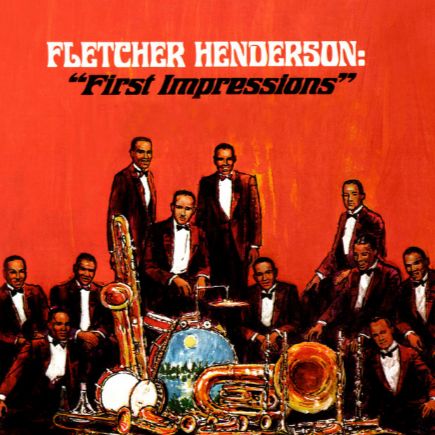King Porter Stomp: des racines du ragtime à l’apogée du swing
Composé en 1905 par Jelly Roll Morton, figure fondatrice du jazz, King Porter Stomp s’impose comme l’un des premiers jalons majeurs de cette musique en pleine gestation. Œuvre charnière entre le ragtime structuré et les libertés expressives du jazz naissant, ce morceau reflète la richesse des traditions afro-américaines qui nourrissent l’invention musicale de Morton.
D’abord enregistré en solo en 1923, puis en duo avec Joe ‘King’ Oliver au cornet l’année suivante, King Porter Stomp puise son inspiration dans l’univers de Porter King, pianiste admiré par Morton auquel il rend ici hommage. L’œuvre combine habilement la pulsation syncopée du ragtime, des inflexions blues et les prémices du swing, esquissant les contours d’un langage musical en pleine mutation.
Rapidement adopté par les orchestres de jazz, le morceau connaît une nouvelle vie dans les années 1930 avec l’émergence des big bands. Avec ses riffs répétitifs et accrocheurs, sa mélodie simple mais percutante, King Porter Stomp devient un véritable hymne de l’ère swing, porté notamment par Fletcher Henderson puis Benny Goodman, qui en livrent des versions marquantes.
Fletcher Henderson aux origines du swing
Le 14 mars 1928, Fletcher Henderson et son orchestre gravaient à New York une version de King Porter Stomp qui, au-delà de sa brillance musicale, marqua un véritable tournant dans l’histoire du jazz orchestral. Cette interprétation, en posant les fondations d’un style plus structuré et plus énergique, annonçait déjà l’ère du swing qui allait dominer la décennie suivante.
Son orchestre réunissait des musiciens de premier plan, parmi lesquels Louis Armstrong, qui avait rejoint l’ensemble en 1924. Par son jeu puissant et syncopé, Armstrong orienta durablement l’orchestre vers une esthétique plus moderne et expressive.
Cet arrangement de King Porter Stomp illustre parfaitement cette mutation stylistique. Plutôt qu’un simple prolongement du ragtime, Henderson en fit une œuvre orchestrale ambitieuse, jouant sur les contrastes entre sections, l’alternance de solos incisifs et une interaction rythmique innovante. Les cuivres et les anches s’y répondent dans un jeu de call and response qui deviendra une marque de fabrique du swing. L’écriture en blocs sonores confère puissance et cohésion à l’ensemble, tandis que la pulsation rythmique, plus fluide que celle du jazz traditionnel, ouvre la voie à une conception orchestrale moderne.
Cette vision anticipatrice aura des prolongements décisifs. En 1935, Benny Goodman fera de King Porter Stomp un tube emblématique du swing, en s’appuyant directement sur les bases posées par Henderson, devenu son arrangeur principal.
King Porter Stomp: de las raíces del ragtime al apogeo del swing
Compuesto en 1905 por Jelly Roll Morton, figura fundadora del jazz, King Porter Stomp se impone como uno de los primeros hitos fundamentales de esta música en gestación. Obra de transición entre el ragtime estructurado y las libertades expresivas del jazz naciente, el tema refleja la riqueza de las tradiciones afroamericanas que alimentan la invención musical de Morton.
Grabado por primera vez en solitario en 1923, y al año siguiente en dúo con Joe ‘King’ Oliver a la corneta, King Porter Stomp se inspira en el universo de Porter King, pianista admirado por Morton a quien rinde homenaje en esta pieza. La obra combina hábilmente la pulsación sincopada del ragtime, matices de blues y los primeros elementos del swing, esbozando los contornos de un lenguaje musical en evolución.
Rápidamente adoptado por las orquestas de jazz, el tema conoce una nueva vida en los años 30 con la aparición de las big bands. Con sus riffs repetitivos y pegadizos, y su melodía sencilla pero contundente, King Porter Stomp se convierte en un verdadero himno de la era del swing, impulsado notablemente por Fletcher Henderson y posteriormente por Benny Goodman, quienes ofrecen versiones memorables.
Fletcher Henderson en los orígenes del swing
El 14 de marzo de 1928, Fletcher Henderson y su orquesta grabaron en Nueva York una versión de King Porter Stomp que, más allá de su brillantez musical, marcó un verdadero punto de inflexión en la historia del jazz orquestal. Esta interpretación, al sentar las bases de un estilo más estructurado y enérgico, anunciaba ya la era del swing que dominaría la década siguiente.
Su orquesta reunía a músicos de primer nivel, entre ellos Louis Armstrong, quien se había incorporado en 1924. Con su estilo poderoso y sincopado, Armstrong orientó de manera duradera al conjunto hacia una estética más moderna y expresiva.
Este arreglo de King Porter Stomp ilustra de manera ejemplar dicha transformación estilística. Más que una simple prolongación del ragtime, Henderson lo convirtió en una obra orquestal ambiciosa, jugando con los contrastes entre secciones, la alternancia de solos incisivos y una interacción rítmica innovadora. Los metales y las maderas dialogan en un call and response que se convertirá en una de las señas de identidad del swing. La escritura en bloques sonoros aporta potencia y cohesión al conjunto, mientras que la pulsación rítmica, más fluida que la del jazz tradicional, abre la vía a una concepción orquestal moderna.
Esta visión anticipadora tendría prolongaciones decisivas. En 1935, Benny Goodman convertiría King Porter Stomp en un éxito emblemático del swing, apoyándose directamente en las bases establecidas por Henderson, que se había convertido en su principal arreglista.
King Porter Stomp: dalle radici del ragtime all’apice dello swing
Composto nel 1905 da Jelly Roll Morton, figura fondatrice del jazz, King Porter Stomp si afferma come una delle prime pietre miliari di questa musica in piena evoluzione. Opera di transizione tra il ragtime strutturato e le libertà espressive del jazz nascente, il brano riflette la ricchezza delle tradizioni afroamericane che nutrono l’invenzione musicale di Morton.
Registrato per la prima volta in solo nel 1923, e l’anno successivo in duo con Joe ‘King’ Oliver al cornetto, King Porter Stomp trae ispirazione dall’universo di Porter King, pianista ammirato da Morton al quale il pezzo rende omaggio. L’opera combina abilmente la pulsazione sincopata del ragtime, inflessioni blues e i primi accenni di swing, delineando i contorni di un linguaggio musicale in trasformazione.
Adottato rapidamente dalle orchestre jazz, il brano conosce una nuova vita negli anni Trenta con l’emergere delle big band. Con i suoi riff ripetitivi e accattivanti e la sua melodia semplice ma incisiva, King Porter Stomp diventa un autentico inno dell’epoca swing, portato al successo in particolare da Fletcher Henderson e poi da Benny Goodman, che ne offrono versioni memorabili.
Fletcher Henderson alle origini dello swing
Il 14 marzo 1928, Fletcher Henderson e la sua orchestra incisero a New York una versione di King Porter Stomp che, oltre alla sua brillantezza musicale, segnò una vera svolta nella storia del jazz orchestrale. Questa interpretazione, ponendo le basi di uno stile più strutturato ed energico, preannunciava già l’era dello swing destinata a dominare il decennio successivo.
La sua orchestra riuniva musicisti di primo piano, tra cui Louis Armstrong, entrato a far parte dell’ensemble nel 1924. Con il suo stile potente e sincopato, Armstrong orientò in modo duraturo l’orchestra verso un’estetica più moderna ed espressiva.
Questo arrangiamento di King Porter Stomp illustra perfettamente tale mutamento stilistico. Più che una semplice prosecuzione del ragtime, Henderson ne fece un’opera orchestrale ambiziosa, giocando sui contrasti tra sezioni, l’alternanza di assoli incisivi e un’interazione ritmica innovativa. Gli ottoni e i legni si rispondono in un call and response che diventerà un segno distintivo dello swing. La scrittura a blocchi sonori conferisce potenza e coesione all’insieme, mentre la pulsazione ritmica, più fluida di quella del jazz tradizionale, apre la strada a una concezione orchestrale moderna.
Questa visione anticipatrice avrebbe avuto sviluppi decisivi. Nel 1935, Benny Goodman trasformò King Porter Stomp in un successo emblematico dello swing, basandosi direttamente sulle fondamenta poste da Henderson, divenuto il suo principale arrangiatore.
King Porter Stomp: from the roots of ragtime to the height of swing
Composed in 1905 by Jelly Roll Morton, a foundational figure in jazz, King Porter Stomp stands as one of the earliest major milestones of the emerging genre. A pivotal work bridging the structured form of ragtime and the expressive freedoms of early jazz, the piece reflects the richness of African American traditions that fueled Morton’s musical creativity.
First recorded as a solo in 1923, and then in a duo with Joe ‘King’ Oliver on cornet the following year, King Porter Stomp draws inspiration from the world of Porter King, a pianist Morton admired and to whom he pays tribute in this composition. The work skillfully blends the syncopated pulse of ragtime, blues inflections, and early swing elements, outlining the contours of a developing musical language.
Quickly embraced by jazz orchestras, the piece found new life in the 1930s with the rise of big bands. With its catchy, repetitive riffs and its simple yet impactful melody, King Porter Stomp became a true anthem of the swing era—most notably through memorable versions by Fletcher Henderson and later Benny Goodman.
Fletcher Henderson at the origins of swing
On March 14, 1928, Fletcher Henderson and his orchestra recorded in New York a version of King Porter Stomp that, beyond its musical brilliance, marked a true turning point in the history of orchestral jazz. This performance, by laying the foundations of a more structured and energetic style, already heralded the swing era that would dominate the following decade.
His orchestra featured top-tier musicians, among them Louis Armstrong, who had joined in 1924. With his powerful, syncopated playing, Armstrong steered the ensemble toward a more modern and expressive aesthetic.
This arrangement of King Porter Stomp perfectly illustrates this stylistic shift. Rather than a simple extension of ragtime, Henderson turned it into an ambitious orchestral work, built on contrasts between sections, incisive solos, and innovative rhythmic interplay. The brass and reeds engage in a call and response that would become a hallmark of swing. Block scoring gave the ensemble power and cohesion, while the rhythmic pulse, more fluid than that of traditional jazz, paved the way for a modern orchestral conception.
This forward-looking vision would have decisive consequences. In 1935, Benny Goodman turned King Porter Stomp into a defining swing hit, building directly on the foundations laid by Henderson, who had become his principal arranger.


